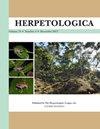物种分布模型揭示了一种地方珍稀蛇类在其地理分布区外围出现的情况
IF 1.1
3区 生物学
Q2 ZOOLOGY
引用次数: 0
摘要
摘要:随着生物多样性损失的增加,栖息地管理和物种保护计划越来越重要。对于许多物种来说,我们缺乏实施栖息地管理或保护计划所需的数据,因为这些物种可能很罕见或很难探测到,特别是在地理范围的边缘。对于蛇类来说,情况可能尤其如此。例如,侏儒响尾蛇(Sistrurus miliarius)在其分布区的北端受到州级保护,但人们对该物种在这一地区的了解甚少,仅来自于过去 40 年中收集的 30 次观察结果。这给保护状况留下了相当大的不确定性,因此需要更好地了解栖息地适宜性及其地理分布。因此,我们的研究目标是通过 Maxent 物种分布算法确定影响 S. miliarius 在其分布区北部分布模式的景观尺度环境变量,并通过标准化公路巡回横断面(n = 43)进行现场监测,以评估模型的适宜性。最终的物种分布模型显示,适宜的栖息地(2045.96 平方公里)主要由孤立成片的河岸地区组成。这些栖息地主要由沙质土壤和低海拔林区组成。根据我们的建模工作,我们的现场监测为该物种带来了 12 项新记录(增加了 28.57%)。总体而言,我们的物种分布模型表明,在我们的研究区域内,S. miliarius 的适宜栖息地仅限于与田纳西河下游河谷相关的河流或河岸栖息地。本研究中使用的方法采用了一种策略,以更好地了解出现在大面积地理区域的稀有或隐秘物种的适宜栖息地。本文章由计算机程序翻译,如有差异,请以英文原文为准。
Species Distribution Modeling Reveals Insights into the Occurrence of a Locally Rare Snake at the Periphery of its Geographic Range
Abstract: Habitat management and species conservation plans are increasingly important as biodiversity losses increase. For many species, we lack the necessary data to implement habitat management or conservation plans because the species may be rare or difficult to detect, particularly at the periphery of geographic ranges. This may be especially true for snakes. For example, Pygmy Rattlesnakes (Sistrurus miliarius) have state-level protection at the northern terminus of the range but what little is known about the species in this region is derived from just 30 observations collected over the past 40 yr. This leaves considerable uncertainty regarding conservation status and establishes a need to better understand habitat suitability and their geographic distribution. Therefore, the objectives of our study were to determine landscape-scale environmental variables that influence patterns of distribution for S. miliarius in the northern extent of its range via the Maxent Species Distribution Algorithm coupled with on-site monitoring via standardized road-cruising transects (n = 43) to evaluate model suitability. The resulting species distribution model showed that suitable habitat (∼2045.96 km2) was composed primarily of riparian areas that exist in isolated patches. These habitats were primarily composed of sandy soils and low-elevation forested areas. Our on-site monitoring, informed by our modeling efforts, resulted in 12 new records for the species (an increase of 28.57%). Collectively, our species distribution model suggests that suitable habitat for S. miliarius within our study area is restricted to riverine or riparian habitats associated with the Lower Tennessee River Valley. The methods used in this study employ a strategy to better understand suitable habitat for rare or secretive species that occur across large geographic areas.
求助全文
通过发布文献求助,成功后即可免费获取论文全文。
去求助
来源期刊

Herpetologica
生物-动物学
CiteScore
4.60
自引率
0.00%
发文量
27
审稿时长
>12 weeks
期刊介绍:
Established in 1936, Herpetologica is a quarterly peer-reviewed journal serving herpetologists, biologists, ecologists, conservationists, researchers and the scientific community. The journal contains original research papers and essays about the biology of reptiles and amphibians, and covers many relevant topics including: behavior, conservation, ecology, genetics, morphology, physiology and taxonomy.
 求助内容:
求助内容: 应助结果提醒方式:
应助结果提醒方式:


